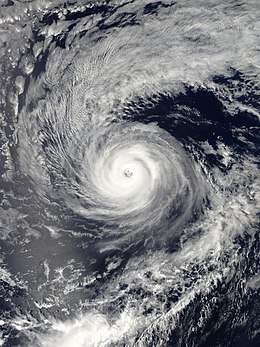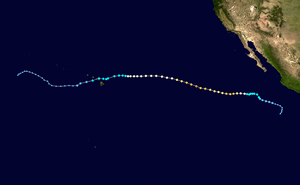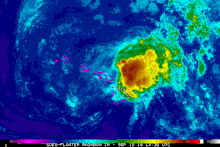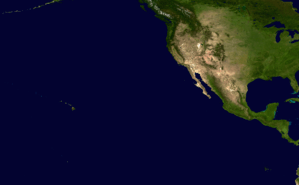Hurricane Olivia (2018)
| Category 4 major hurricane (SSHWS/NWS) | |
 Hurricane Olivia near peak intensity with annular characteristics on September 6 | |
| Formed | September 1, 2018 |
|---|---|
| Dissipated | September 19, 2018 |
| (Remnant low after September 14) | |
| Highest winds |
1-minute sustained: 130 mph (215 km/h) |
| Lowest pressure | 948 mbar (hPa); 27.99 inHg |
| Fatalities | None |
| Damage | Unknown |
| Areas affected | Hawaii |
| Part of the 2018 Pacific hurricane season | |
Hurricane Olivia was the first tropical cyclone to make landfall on Maui and Lanai in recorded history. The fifteenth named storm, ninth hurricane, and sixth major hurricane of the 2018 Pacific hurricane season, Olivia originated from a broad area of low pressure that formed several hundred miles southwest of Mexico on August 30. The disturbance moved west-northwest before developing into a tropical depression on September 1. Due to adverse weather conditions, the depression slowly organized and strengthened into Tropical Storm Olivia on the next day. Olivia then began a period of rapid intensification on September 3, which resulted in Olivia initially peaking as a high-end Category 3 hurricane on September 5. Olivia then began a weakening trend that left it as a low-end Category 2 hurricane. Olivia then began to re-intensify on September 6. On the next day, Olivia peaked as a Category 4 hurricane, with winds of 130 mph (215 km/h) and a minimum central pressure of 948 mbar (28.00 inHg). Six hours later, Olivia began another weakening trend that resulted in the hurricane being downgraded to Category 1 status on September 8, east of the 140th meridian west. On September 9, Olivia entered the Central Pacific Basin. Olivia weakened into a tropical storm on September 11, before making brief landfalls in northwest Maui and Lanai on the next day. Olivia was downgraded to a tropical depression on September 13, continuing to head west. Due to wind shear disrupting Olivia's convection, the system weakened into a remnant low on September 14. Olivia crossed into the West Pacific Basin on September 19 as a remnant low, before dissipating later that day.
Meteorological history

Olivia originated from a broad area of low pressure that formed several hundred miles southwest of Mexico on August 30.[1] The National Hurricane Center (NHC) continued to monitor the disturbance as it moved west-northwest for the next couple of days and gradually became more organized.[2] At 03:00 UTC on September 1, the NHC declared that the low had become Tropical Depression Seventeen-E approximately 425 miles (680 km) southwest of Manzanillo, Mexico.[3] Initially, due to north-northeasterly vertical wind shear, the nascent depression only strengthened slowly, reaching tropical storm status at 09:00 UTC on September 2; at this time the depression was named Olivia.[4] For the next several days, the system would travel west to west-northwest under the influence of a subtropical ridge that extended from central Mexico across the eastern Pacific.[5]
Over the next day and a half, Olivia changed little in strength as wind shear continued to impinge on the system.[6] Late on September 3, however, a central dense overcast developed over Olivia's center of circulation and an inner core began to form, preceding a period of rapid intensification.[7] By 03:00 UTC on September 4, Olivia strengthened into a hurricane,[8] and reached Category 2 status on the Saffir–Simpson scale twelve hours later.[9] At 21:00 UTC on September 4, Olivia reached Category 3 status and thus became the sixth major hurricane of the season.[10] Six hours later, Olivia reached its initial peak intensity, with maximum sustained winds of 125 mph (195 km/h) and a minimum central pressure of 955 mbar (hPa; 28.20 inHg).[11]
Shortly after, however, Olivia began a weakening trend,[12] falling below Category 3 status six hours later.[13] Eventually, Olivia bottomed out as a low-end Category 2 hurricane, before beginning to re-intensify on September 6.[14][15] Olivia regained major hurricane status by 12:00 UTC that day,[16] and peaked as a Category 4 hurricane at 03:00 UTC on September 7, with winds of 130 mph (215 km/h) and a minimum pressure of 948 mbar (hPa; 28.00 inHg). At that time, the NHC noted that Olivia was "an outstanding example of an annular hurricane", with a sharp eye surrounded by a single ring of intense convection.[17] Six hours later, Olivia began another weakening trend as sea surface temperatures decreased and cloud tops around the eye warmed.[18] By 09:00 UTC on September 8, Olivia had weakened to a Category 1 hurricane.[19] At 03:00 UTC on September 9, the Central Pacific Hurricane Center (CPHC) took over the responsibility of monitoring and issuing advisories on Olivia after the hurricane crossed the 140th meridian west and entered the central Pacific.[20]
Early on September 11, Olivia weakened to a tropical storm, after encountering strong wind shear.[21] Late on the same day, Olivia's low level circulation center separated from the deep convection, resulting in a significant increase in forward speed.[22] Olivia rapidly weakened as it approached Hawaii, before making brief landfalls over Maui and Lanai on September 12, at 19:10 UTC and 19:54 UTC respectively, with sustained winds of 45 mph (75 km/h).[23] At 09:00 UTC on September 13, as Olivia was pulling away from Hawaii, the system weakened into a tropical depression.[24] After wind shear continually disrupted Olivia's convection, the system degenerated into a post-tropical remnant low on September 14.[25] On September 19, Olivia's remnant low crossed the International Date Line, entering the West Pacific Basin. The Joint Typhoon Warning Center (JTWC) stated that there was a possibility of redevelopment.[26] Soon after, Olivia quickly lost all of its convection and dissipated, due to wind shear. However, Olivia's remnant energy contributed to the formation of a weak tropical depression, which became Tropical Depression 29W.
Preparations and impact
.jpg)
On September 10, in anticipation of Olivia's landfall in Hawaii, tropical storm watches were issued for Hawaii County, Oahu, and Maui County including the islands of Maui, Molokai, Lanai, and Kahoolawe.[27] At 15:00 UTC, the tropical storm watches for Hawaii County and Maui were changed to tropical storm warnings.[28] At 03:00 UTC on September 11, the watch for Oahu was changed to a tropical storm warning. Additionally, tropical storm watches were issued for Kauai County including the islands of Kauai and Niihau due to the uncertainty of the track.[29] At 21:00 UTC the watches for Kauai and Niihau were changed to tropical storm warnings after the track shifted northward.[30] At 09:00 UTC on September 12, as the path of Olivia became clearer, the warnings for Kauai and Niihau were discontinued.[31]
On September 9, Governor David Ige signed an emergency proclamation declaring the counties of Hawaii, Maui, Kalawao, Kauai, and Honolulu as disaster areas.[32] On September 12, all public schools and post offices were closed in Maui with numerous schools and universities closed elsewhere.[33]
Tropical storm-force winds mainly affected Maui County and Oahu. A peak winds of 55 mph (89 km/h) was observed in Lanai Airport, and a peak winds of 46 mph (74 km/h) was observed in Kuaokala.[34] Widespread rains in Maui County and Oahu from September 11–13 caused numerous instances of flash flooding, with the worst felt in areas along the slopes of the West Maui Mountains. Brief road closures occurred in Oahu on the night of September 12 as a result of the flash floods. In Maui County, rainfall totals reached a maximum of 12.93 in (328 mm) in West Wailuaiki, while on Oahu, rainfall totals peaked at 10.31 in (262 mm) at the Lyon Arboretum in Manoa.[35] Olivia was the first tropical cyclone to make landfall on the islands of Maui and Lanai in recorded history.[36]
See also
- Other tropical cyclones named Olivia
- List of Category 4 Pacific hurricanes
- List of Hawaii hurricanes
- Tropical Storm Irah (1963) – took a very similar track, affected Hawaii as a tropical depression
- Hurricane Raymond (1983) – Category 4 hurricane that made landfall in Oahu as a tropical depression
- Tropical Storm Flossie (2013) – took a similar path and passed just north of Hawaii
- Hurricane Iselle (2014) – similarly intense system that affected the Big Island as a tropical storm
- Hurricane Darby (2016) – Category 3 hurricane that made landfall on the Big Island as a tropical storm
- Hurricane Lane (2018) – Category 5 hurricane that dropped record amounts of rainfall in Hawaii a few weeks before Olivia's landfall
References
- ↑ Brown, Daniel. NHC Graphical Outlook Archive. National Hurricane Center (Report). National Oceanic and Atmospheric Administration. Retrieved 7 September 2018.
- ↑ Roberts, Dave. NHC Graphical Outlook Archive. National Hurricane Center (Report). National Oceanic and Atmospheric Administration. Retrieved 7 September 2018.
- ↑ Cangialosi, John. Tropical Depression Seventeen-E Advisory Number 1. National Hurricane Center (Report). National Oceanic and Atmospheric Administration. Retrieved 7 September 2018.
- ↑ Pasch, Richard. Tropical Storm Olivia Discussion Number 6. National Hurricane Center (Report). National Oceanic and Atmospheric Administration. Retrieved 7 September 2018.
- ↑ Stewart, Stacy. Tropical Depression Seventeen-E Discussion Number 3. National Hurricane Center (Report). National Oceanic and Atmospheric Administration. Retrieved 8 September 2018.
- ↑ Roberts, Dave. Tropical Storm Olivia Discussion Number 10. National Hurricane Center (Report). National Oceanic and Atmospheric Administration. Retrieved 7 September 2018.
- ↑ Blake, Eric. Tropical Storm Olivia Discussion Number 11. National Hurricane Center (Report). National Oceanic and Atmospheric Administration. Retrieved 7 September 2018.
- ↑ Blake, Eric. Hurricane Olivia Advisory Number 13. National Hurricane Center (Report). National Oceanic and Atmospheric Administration. Retrieved 7 September 2018.
- ↑ Beven, Jack. Hurricane Olivia Advisory Number 15. National Hurricane Center (Report). National Oceanic and Atmospheric Administration. Retrieved 7 September 2018.
- ↑ Beven, Jack. Hurricane Olivia Advisory Number 16. National Hurricane Center (Report). National Oceanic and Atmospheric Administration. Retrieved 7 September 2018.
- ↑ Blake, Eric. Hurricane Olivia Advisory Number 17. National Hurricane Center (Report). National Oceanic and Atmospheric Administration. Retrieved 7 September 2018.
- ↑ Roberts, Dave. Hurricane Olivia Advisory Number 18. National Hurricane Center (Report). National Oceanic and Atmospheric Administration. Retrieved 8 September 2018.
- ↑ Beven, Jack. Hurricane Olivia Advisory Number 19. National Hurricane Center (Report). National Oceanic and Atmospheric Administration. Retrieved 8 September 2018.
- ↑ Avila, Lixion. Hurricane Olivia Advisory Number 21. National Hurricane Center (Report). National Oceanic and Atmospheric Administration. Retrieved 8 September 2018.
- ↑ Pasch, Richard. Hurricane Olivia Advisory Number 22. National Hurricane Center (Report). National Oceanic and Atmospheric Administration. Retrieved 8 September 2018.
- ↑ Beven, Jack. Hurricane Olivia Special Advisory Number 23. National Hurricane Center (Report). National Oceanic and Atmospheric Administration. Retrieved 8 September 2018.
- ↑ Avila, Lixion. Hurricane Olivia Discussion Number 26. National Hurricane Center (Report). National Oceanic and Atmospheric Administration. Retrieved 8 September 2018.
- ↑ Stewart, Stacy. Hurricane Olivia Discussion Number 27. National Hurricane Center (Report). National Oceanic and Atmospheric Administration. Retrieved 8 September 2018.
- ↑ Brown, Daniel. Hurricane Olivia Advisory Number 31. National Hurricane Center (Report). National Oceanic and Atmospheric Administration. Retrieved 8 September 2018.
- ↑ Ballard, Robert. Hurricane Olivia Advisory Number 34. Central Pacific Hurricane Center (Report). National Oceanic and Atmospheric Administration. Retrieved 9 September 2018.
- ↑ Ballard, Robert. Hurricane Olivia Intermediate Advisory Number 41A. Central Pacific Hurricane Center (Report). National Oceanic and Atmospheric Administration. Retrieved 12 September 2018.
- ↑ Ballard, Robert. Tropical Storm Olivia Discussion Number 45. Central Pacific Hurricane Center (Report). National Oceanic and Atmospheric Administration. Retrieved 12 September 2018.
- ↑ Wroe, Derek. Tropical Storm Olivia Discussion Number 49. Central Pacific Hurricane Center (Report). National Oceanic and Atmospheric Administration. Retrieved 12 September 2018.
- ↑ Houston, Sam. Tropical Depression Olivia Advisory Number 51. Central Pacific Hurricane Center (Report). National Oceanic and Atmospheric Administration. Retrieved 13 September 2018.
- ↑ Wroe, Derek. Post-Tropical Cyclone Olivia Discussion Number 54. Central Pacific Hurricane Center (Report). National Oceanic and Atmospheric Administration. Retrieved 14 September 2018.
- ↑ SUBJ/SIGNIFICANT TROPICAL WEATHER ADVISORY FOR THE WESTERN AND SOUTH PACIFIC OCEANS. Joint Typhoon Warning Center (Report). Naval Meteorology and Oceanography Command. Retrieved 26 September 2018.
- ↑ Ballard, Robbie. Hurricane Olivia Advisory Number 38. Central Pacific Hurricane Center (Report). National Oceanic and Atmospheric Administration. Retrieved 10 September 2018.
- ↑ Houston, Sam. Hurricane Olivia Advisory Number 40. Central Pacific Hurricane Center (Report). National Oceanic and Atmospheric Administration. Retrieved 10 September 2018.
- ↑ Ballard, Robert. Tropical Storm Olivia Advisory Number 42. Central Pacific Hurricane Center (Report). National Oceanic and Atmospheric Administration. Retrieved 12 September 2018.
- ↑ Ballard, Robert. Tropical Storm Olivia Advisory Number 45. Central Pacific Hurricane Center (Report). National Oceanic and Atmospheric Administration. Retrieved 12 September 2018.
- ↑ Birchard, Tom. Tropical Storm Olivia Advisory Number 47. Central Pacific Hurricane Center (Report). National Oceanic and Atmospheric Administration. Retrieved 12 September 2018.
- ↑ "INTERVIEW: Governor signs emergency proclamation as Olivia heads toward Hawaii". Khon2. Khon2. Retrieved 10 September 2018.
- ↑ Boyette, Chris. "Tropical Storm Olivia makes landfall in Hawaii". CNN. CNN. Retrieved 12 September 2018.
- ↑ Hawaii Public Information Statements (Report). National Weather Service Office in Honolulu, Hawaii. September 12, 2018. Archived from the original on September 16, 2018. Retrieved September 13, 2018.
- ↑ Hawaii Public Information Statements (Report). National Weather Service Office in Honolulu, Hawaii. September 13, 2018. Archived from the original on September 16, 2018. Retrieved September 16, 2018.
- ↑ Gomes, Andrew. "Olivia makes brief but historic landfall on Maui". Honolulu Star Advertiser. Honolulu Star Advertiser. Retrieved 15 September 2018.
External links
| Wikimedia Commons has media related to Hurricane Olivia (2018). |
- The National Hurricane Center's advisory archive on Hurricane Olivia
- The Central Pacific Hurricane Center's advisory archive on Hurricane Olivia
![]()

